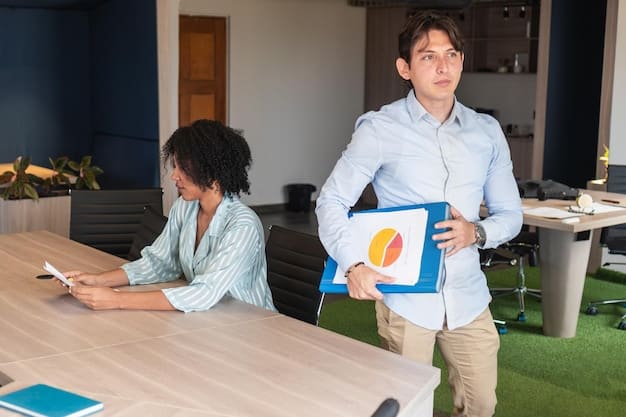Maximize Workplace Impact: Adapting Learning Styles for 2025

Learning Styles in the Workplace: How to Adapt Your Training Methods for Maximum Impact in 2025 explores the significance of understanding diverse learning preferences to enhance employee training and development, ensuring a more engaged, productive, and adaptive workforce.
In the rapidly evolving landscape of the modern workplace, understanding and adapting to diverse learning styles is paramount. Learning Styles in the Workplace: How to Adapt Your Training Methods for Maximum Impact in 2025 delves into the critical strategies for optimizing employee development through tailored learning experiences.
The Evolving Importance of Learning Styles in 2025
As we move towards 2025, the relevance of accommodating varied learning styles in the workplace becomes increasingly apparent. Traditional one-size-fits-all training approaches are no longer sufficient for engaging and retaining a diverse workforce.
Understanding Different Learning Styles
Before diving into how to adapt your training methods, it’s crucial to grasp the core learning styles that employees typically exhibit.
- Visual Learners: These individuals learn best through visual aids such as charts, graphs, and videos.
- Auditory Learners: They prefer lectures, discussions, and audio recordings to absorb information effectively.
- Kinesthetic Learners: Hands-on activities, simulations, and real-world applications are ideal for this group.
- Read/Write Learners: These learners excel through written materials, note-taking, and reading assignments.
By understanding these different preferences, organizations can design training programs that cater to a wider audience, increasing comprehension and retention rates.
Assessing Learning Styles in Your Workforce

Identifying learning styles within your team is a critical first step. This assessment process helps to tailor training methods effectively.
Methods for Assessing Learning Styles
Several tools and strategies can be used to assess individual learning preferences:
- Questionnaires and Surveys: Standardized questionnaires like the VARK questionnaire can provide insights into preferred learning modalities.
- Observation: Observing how employees approach tasks and engage with different training materials can reveal their natural learning tendencies.
- Self-Assessment: Encourage employees to reflect on their past learning experiences and identify the methods that have worked best for them.
A comprehensive approach, incorporating multiple assessment methods, provides a more accurate and nuanced understanding of each employee’s learning style.
Adapting Training Methods for Visual Learners
Visual learners thrive on information presented in a visually engaging format. Adapting training to accommodate these learning styles can significantly improve learning outcomes.
Incorporating Visual Aids
One of the easiest ways to cater to visual learners is by incorporating visual aids into training programs:
- Use of Diagrams and Charts: Visual representations can simplify complex information and make it easier to understand.
- Video Tutorials and Demonstrations: Videos provide a dynamic way to present information and demonstrate processes.
- Infographics: Combine text and visuals to create engaging and easily digestible summaries of key concepts.
Designing Visually Appealing Materials
The aesthetic appeal of training materials also plays a crucial role in engaging visual learners. Consider these factors:
- Color Schemes: Use color strategically to highlight important information and create visual interest.
- Typography: Choose fonts that are easy to read and visually appealing.
- Layout and Design: Organize content in a clear and logical manner, using white space to avoid visual clutter.
By prioritizing visual elements, organizations can create training experiences that resonate with visual learners, making them more effective and enjoyable.
Catering to Auditory Learning Preferences
Auditory learners absorb information best through listening and verbal interaction. Adapting training to suit these learning styles involves leveraging sound and discussion.
Utilizing Audio-Based Training
Audio-based training methods can be highly effective for auditory learners:
- Lectures and Presentations: Live or recorded lectures allow auditory learners to listen and process information in real-time.
- Podcasts: Educational podcasts can provide on-the-go learning opportunities for auditory learners.
- Discussions and Group Activities: Engaging in discussions and collaborative activities allows auditory learners to verbalize and reinforce their understanding.
Moreover, incorporating Q&A sessions ensures active engagement and provides a platform for clarifying doubts.
Incorporating Kinesthetic Activities for Hands-On Learners

Kinesthetic learners learn best by doing. Hands-on activities and practical applications are essential for engaging these learning styles.
Hands-On Training Techniques
Implementing these activities will enhance the training experience of kinesthetic learners:
- Simulations and Role-Playing: These activities allow learners to apply their knowledge in a safe and controlled environment.
- Workshops and Demonstrations: Hands-on workshops provide practical experience and allow learners to experiment with new skills.
- Field Trips and Site Visits: Visiting relevant sites can offer kinesthetic learners a real-world perspective on the concepts they are learning.
These hands-on activities solidify learning and make it more memorable for kinesthetic learners.
Leveraging Read/Write Learning Styles in the Workplace
Read/write learners excel when information is presented through written text. Tailoring training materials to these learning styles is crucial for effective learning.
Effective Reading and Writing Strategies
To accommodate read/write learners, consider the following approaches:
- Written Materials: Provide comprehensive written materials, such as manuals, guides, and articles, to support the training content.
- Note-Taking: Encourage note-taking during lectures or presentations to help learners process and retain information.
- Written Assignments: Assign tasks that require learners to summarize, analyze, or synthesize information in writing.
By focusing on written communication, organizations can enhance the learning experience for read/write learners.
Future Trends in Adapting Learning Styles
Looking ahead to 2025, several emerging trends are shaping how organizations adapt to different learning styles.
Personalized Learning Technologies
Adaptive learning platforms utilize AI to tailor content to individual learner’s needs and preferences. These platforms adjust the difficulty level, pace, and modality of instruction based on real-time feedback, creating a truly personalized learning experience. The use of VR and AR is also expected to grow, transforming training into immersive experiences for people with different learning styles.
Microlearning and Mobile Learning
Microlearning breaks down training content into small, easily digestible chunks, which can be accessed on mobile devices. This approach allows learners to consume information at their own pace and in their preferred format, making it ideal for accommodating diverse learning styles.
| Key Aspect | Brief Description |
|---|---|
| 📊 Visual Learners | Benefit from charts, diagrams, and video tutorials. |
| 🔊 Auditory Learners | Learn best through lectures, podcasts, and group discussions. |
| 🖐️ Kinesthetic Learners | Thrive on hands-on activities, simulations, and workshops. |
| ✍️ Read/Write Learners | Prefer written materials, note-taking, and reading assignments. |
Frequently Asked Questions
▼
The primary learning styles are visual, auditory, kinesthetic, and read/write. Each style represents a different way individuals prefer to absorb and process information, affecting how effectively they learn in various settings.
▼
Adapting training methods increases engagement, improves knowledge retention, and enhances job performance. By catering to diverse learning styles, organizations create a more inclusive and effective training environment.
▼
You can use questionnaires, observation, and self-assessment tools. Standardized questionnaires like VARK provide insights, while observing how employees approach tasks can reveal their natural learning preferences.
▼
Incorporate diagrams, charts, video tutorials, and infographics. Use color strategically and choose readable fonts to enhance the visual appeal of your training materials, making learning both effective and enjoyable.
▼
Personalized learning platforms use AI to tailor content, and microlearning delivers bite-sized information accessible on mobile devices. VR and AR create immersive experiences, ensuring that training adapts to individual needs.
Conclusion
Adapting training methods to accommodate diverse learning styles is not just a trend but a necessity for organizations aiming to maximize employee potential. By understanding and catering to visual, auditory, kinesthetic, and read/write preferences, companies can create more engaging, effective, and inclusive learning experiences. Looking ahead to 2025, personalized learning technologies and microlearning approaches will further revolutionize how organizations approach employee development. Embracing these strategies ensures a workforce that is not only well-trained but also empowered to thrive in an ever-evolving business world.





